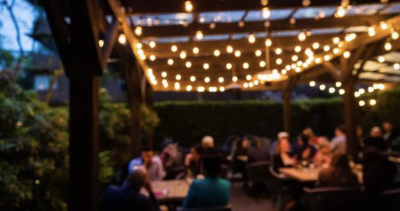Gong! The Gamelan Festival builds the Bali connection
Gong! The Gamelan Festival finds everything from mesmerizing temple music to bagpipes, Balkan singing, and even some John Cage.
At home in Indonesia, gamelan is more than just a kind of music—it’s a way of life. So much so, in fact, that Gamelan Gita Asmara’s I Wayan Sudirana is mildly taken aback when asked how he came to be a professional musician.
“I’m Balinese, and the music in Bali is not for entertainment,” the UBC doctoral candidate explains by phone, in the gentle lilt typical of English-speaking Indonesians. “The music is played as part of the ritual, so since I was very young my father always brought me to a temple that had ceremonies where the music was everywhere. Also, the way the music is made is in the community, so everyone who is a member of the community is obligated to participate. Every time there was a gamelan rehearsal in the community, my father had to be there, and so he brought me and put me in his lap. That is how I was introduced to the gamelan—and then when I was four years old, maybe, or five, I started to play on instruments that were in our house.
“I still don’t feel like I am professional at this,” Sudirana continues. “If I’m teaching my music here, it’s not for money. It’s part of my ritual, and something that I give back to my culture.”
In the course of our half-hour interview, Gita Asmara’s music director explains that music is only part of everyday ritual in his culture; even food is painstakingly prepared according to ancient specifications—and then offered to the gods before it is consumed by its human makers. But there is one area where Bali and Canada intersect: the instruments used in gamelan music are generally owned by community organizations, rather than individuals.
In Bali, that means the neighbourhood temple. And in Vancouver, scholarly institutions have adopted all three of our city’s larger gamelan orchestras. UBC sponsors Gamelan Gita Asmara as part of its ethnomusicology department; SFU is home to Gamelan Madu Sari, which specializes in Javanese music; and the smaller, Sundanese-style Gamelan Si Pawit is, appropriately enough, housed on the smaller Vancouver Community College campus. All three are featured in Gong! The Gamelan Festival, at SFU Woodward’s in the Goldcorp Centre for the Arts from Friday to Sunday (May 18 to 20).
Gita Asmara’s two concerts will feature the debut of Sudirana’s Tabuh Pisan Bhaskara, which he’s worked up as part of his doctoral dissertation on the gong gede temple music of Batur, in the Balinese highlands. In contrast to the speedy, baroque complexity of most contemporary Balinese music, the gong gede style is almost solemn, relying on larger and deeper-toned instruments than is the norm. While Sudirana and his Vancouver colleagues don’t have access to Batur-style metallophones—they’re unique to the village—the composer has borrowed a traditional form known as Tabuh Pisan, then added his own modern twist to it.
“Bhaskara is a Sanskrit word which means ‘sunshine’,” he explains. “So Tabuh Pisan is the structure, and Bhaskara is the piece I made, which reflects my hope, basically. Today in Bali there are so many composers that are afraid to take the old melodies and then elaborate on them based on their own interpretation. So my hope is that this piece could be like sunshine, to open their minds.”
Minds will certainly be opened when Gamelan Si Pawit and Gamelan Alligator Joy—Madu Sari’s experimentally inclined sister group—share the stage. On that bill—along with a new work for gamelan, bagpipes, and Balkan singing by the ever-inventive Michael O’Neill—will be the return of Haikai, which Toronto’s Evergreen Club Gamelan commissioned from the late new-music luminary John Cage in the 1980s.
Si Pawit mastermind and CBC producer Jon Siddall was working with the Evergreen Club at the time, and recalls contacting Cage at home in New York City. The great radical, whose revolutionary pieces for prepared piano had been inspired by gamelan, was interested, but there was a catch: he’d need to be collected at the Toronto airport and driven to the Evergreen Club’s studio, and Siddall didn’t have a vehicle.
“As soon as I put the phone down, I realized ‘You idiot! Just steal a car!’” Siddall says, laughing. “So I phoned him back and said ‘John, I think I can find a car,’ and we worked out an arrangement.
“It was fascinating to see him walk into the room,” he continues. “Because quite literally he immediately started to turn over every stone, so to speak. He wanted to turn the pot gongs upside down and strike them and see what that sounded like. His immediate inclination was to prepare the gamelan, and that’s really one of the essential ingredients of the piece. He prepared the piano to make it sound like a gamelan, and then he prepared the gamelan—and it doesn’t make it sound like a piano. But it does make it sound like something beautiful and different. It sounds like Cage.”
And even though Haikai has none of the traditional elements that are so much a part of Tabuh Pisan Bhaskara, it, too, has some of the meditative beauty of temple music.
“It’s a bit like a walk through a Zen garden,” says Siddall. “It’s spare, beautiful, and very clean, with unexpected moments. It’s lovely.”
Gamelan Gita Asmara plays the Fei and Milton Wong Experimental Theatre at SFU Woodward’s in the Goldcorp Centre for the Arts on Friday and Saturday (May 18 and 19). Gamelan Si Pawit and Gamelan Alligator Joy appear at the same venue on Sunday (May 20).















Comments